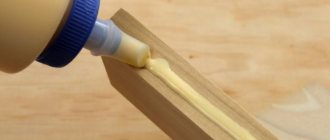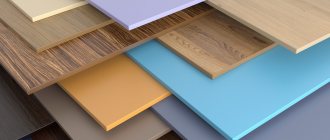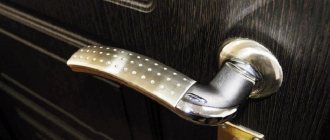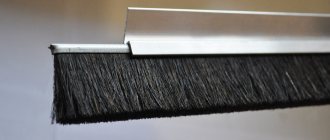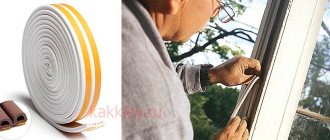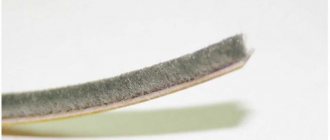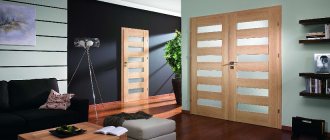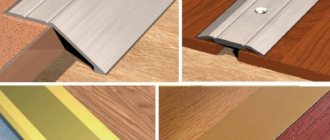When choosing a metal entrance door, happy home owners are puzzled by the thickness of the steel sheet, the design of the locks, the number of stiffeners, the presence of peepholes and chains. But for some reason, few people pay attention to the type of seal for the front door. But this seemingly inconspicuous detail does a lot of work every day. In this article we will talk about how to choose a seal for a metal entrance door.
Sealant: is it possible to do without it?
The seal is a flexible tape that runs along the entire length of the door between the frame and the leaf. This detail, mandatory for any steel door, significantly increases the comfort of living in a house or apartment:
- protects the house from drafts from the street,
- becomes a reliable barrier to noise from the entrance, for example, slamming of the entrance door,
- does not let in odors from the street and does not release them outside the apartment,
- participates in thermal insulation and helps retain heat longer,
- increases the tightness of the door seal,
- improves fire performance - the sealing material becomes an additional barrier to smoke and fire,
- does not change its shape under the influence of temperature fluctuations, and the tightness of the door is not compromised even at extreme sub-zero or positive temperatures,
- The seal absorbs shocks, and when selected correctly, the problem of knocks and squeaks of the closing door goes away.
It is not difficult to install it on the door - at the factory there is an adhesive layer on the tape. It is much more difficult to choose - manufacturers offer a huge selection of seals for different tastes, for standard and unusual doors. To choose the right seal, we will talk about the quality criteria of the tape for tightness.
Types of seals for iron entrance doors: classification according to installation location
Existing products can be classified by location. Depending on the installation area, seals are:
- threshold;
- contour;
- fire protection.
Threshold varieties are not only magnetic. Most often, such seals are equipped with an automatic control system. Thanks to this, the profile can be “adjusted” to the size of the gap that forms between the floor and the door leaf. Moreover, both in the open and closed positions. These seals are used in cases where the door structure does not have a threshold to prevent the formation of drafts.
Contour products are the simplest and most common. During installation, they are fixed around the entire perimeter of the door frame or leaf. This allows you to eliminate all existing gaps and cracks. Contour options are ideal for entrance doors. In such cases, it is advisable to use products with a triple profile.
Note! Three-circuit seals are installed on fire doors. Such products significantly increase the thickness of the door leaf and its weight. For this reason, it is advisable to strengthen the box and install particularly durable fittings.
Placement of the door seal on the threshold.
In rooms with a high level of fire hazard, it is advisable to use a special type of contour seal - thermally expanding. Exposure to heat or smoke triggers a chemical reaction. The material foams or expands, preventing air from entering the room. Due to lack of oxygen, the fire decreases. These products are called fireproof.
Seal characteristics
A metal entrance door lasts for decades, and so that the tape does not have to be changed at the very beginning of its service life, monitor its parameters:
- resistance to damage - it allows the material to withstand frequent slamming of doors without problems,
- strength - the ability to perform functions without deformation or damage,
- elasticity - the material bends and does not break, and its softness allows it to absorb shock well,
- resistance to wear, even with temperature fluctuations,
- maintaining shape even when deformed,
- close proximity to surfaces.
Seals are manufactured strictly in accordance with GOST, and reputable companies comply with all regulatory requirements.
So, what kind of seals are there for a metal entrance door? Let’s go through the points.
Foam rubber and polyurethane types
Foam tape is the most affordable, simplest option. The presence of a self-adhesive base allows you to insulate the doorway in a short time, without the need to make any effort or have additional material. It can also be secured with small nails if the surface is made of wood. Foam rubber is a good protection, but its fragile structure does not allow it to withstand difficult operating conditions; it is negatively affected by: humidity, dirt, temperature changes.
Gradually it becomes unusable, shrinks, crushes, crumbles. Most often, foam rubber tape is used as a seal for interior doors.
A type of door seal is a polyurethane product, which, thanks to the self-adhesive film on one side, is easily fixed to the door. Its area of application includes wooden doors. Metal structures quickly damage the product, as a result of which the heat-protective qualities decrease.
Profile form
The tape is the main structure of all profiles, but it is given different shapes in production. A void may form inside the tape, improving the thermal insulation qualities of the material. For simplicity, the manufacturer marks tapes of different shapes with letters of the Latin alphabet, which are similar to the profile shape: P, V, E, D, O, K, C.
To accurately select a seal, measure the gaps between the canvas and the opening they will close. This is an important condition for choosing the shape of the tape:
- for minimum gaps of 1-3 mm - polyurethane foam and foam rubber seal,
- 3 mm gaps are perfectly closed by tape with a profile in the form of the letters C, E and K,
- gaps of 3-5 mm are laid with material shaped like the letters P or V,
- for particularly large gaps greater than 5 mm, it is recommended to buy a seal marked O or D.
Classification of sealants by texture: liquid foam rubber, flexible and pile tapes
Based on texture, flexible, liquid and pile types of products are distinguished. Each type of seal is used for specific purposes. Flexible tapes have the form of profiles with a smooth surface. Silicone and rubber are used for their production. This category also includes magnetic gaskets for door structures.
Foam rubber is the most popular material for gluing doors and windows.
Liquid options are used to insulate the fabric. The material is under pressure inside the cylinder. This version of the seal resembles the liquid equivalent of foam rubber. Pile products were among the first to appear on the market. Felt is mainly used for their production. Pile sealants are available in the form of tapes and strands. There are artificial analogues of this material made from synthetics on sale.
How is it mounted on the door?
The easiest way is to buy a material with an adhesive base - just remove the film and press the tape tightly to the metal. But there are other profile options:
- self-adhesive - a cavity is formed inside them, which makes it possible to increase the tightness of the fit. The material for them is high-strength rubber,
- grooved - this type is best suited for PVC doors; they are made of softer rubber. They are distinguished by simple installation - the seal is cut to the shape of grooves into which it easily fits,
- magnetic – this is a frame with the outlines of a door of high precision. The seal consists of two parts, one of them contains a magnet, and the second is made of soft shock-absorbing material. A good option for steel entrance doors, characterized by long service life and resistance to environmental conditions. This is a triple profile, two parts are attached to the door and one to the frame. Its operation is based on the principle of attracting powerful magnets. True, there are several nuances: it is difficult for children or old people to enter and exit, and when installing medium-strong magnets, the door allows cold, drafts and odors to pass through. The Klin Doors company offers a large catalog of seals for metal doors, giving preference to rubber, silicone and magnetic ones.
Execution color
Today there are products on sale in a variety of colors, thanks to which you can freely choose the most compatible shade with the door and frame on which the seal is attached. White material can be preferred when there is a need to insulate door structures made of plastic of a similar color.
The black rubber seal is great for protecting entry doors from cold penetration and extraneous noise. In general, for metal structures it is optimal to choose a material of dark shades and colors that go well with it.
For colored metal-plastic doors, you can choose a material of a similar color and even purchase it from the same manufacturer that produces them. Transparent silicone sealing strips combine well with door structures and are visually less noticeable on their surface.
Silicone or rubber?
Manufacturers use materials of various price categories for seals - it is not difficult to get lost in such variety. Let us announce the list of the most popular materials for the production of seals:
- foam rubber is a democratic, inexpensive material, easy to apply and use. It is equally easy to install on both wooden and steel doors. True, there are nuances - the foam rubber seal quickly loses its properties and requires replacement.
- rubber is a special type of rubber that is resistant to cracking. It is indifferent to temperature differences and bright sunlight, while at the same time providing an excellent level of sound and heat insulation. In production, rubber is tested for resistance to oils and acids, so it has a significant service life.
- Silicone is a powerful competitor to rubber seals due to its properties. Most often it is selected for insulation and soundproofing of metal entrance doors for social, entertainment and medical institutions, as well as buildings with high traffic volumes. Silicone is a safe material for people and nature; it does not provoke allergies and does not poison the air with toxic substances.
- the polyurethane seal is inferior in quality to the previous two, comparable in characteristics to foam rubber. These two materials can be used for profiles only on interior doors, and their advantages include low price and ease of covering the door.
Types of sealing strips for doors by configuration type
Existing types of products are classified according to different criteria. They differ in material, shape, color, size and purpose.
There are several types of configuration:
- Tape - soft products in the form of cords about 9 mm wide. The section of the tape has a rectangular shape.
- Tubular - widely used as a seal for iron doors, although the ability to seal the structure is much lower than that of strip doors.
- Groove - made in the form of soft rubber profiles, they are hollow inside. On one side of the products there is a brush, which facilitates the installation of the seal in the groove.
- Mortise - designed for door structures made of wood. Installation is carried out in a pre-cut recess in the box.
- Spring - products are installed not on the door, but directly on the frame. The area where they are installed must have a perfectly flat surface, otherwise the seal will not be able to fully perform its function.
- Folding - intended exclusively for doors with a folding leaf. These include interior structures such as a book or an accordion.
Groove rubber seals.
A rubber profile with a complex configuration is considered a universal option. It is installed on both entrance and interior structures. Available in several types of rubber with varying degrees of density. Standard width is from 8 to 10 mm.
Choosing a seal: what to do before buying?
A reliable seller will definitely tell you about the intricacies of a specific material for the seal, advise the best one for your door, and talk about which seal is best for a metal entrance door. But still, to clarify, we advise you to inquire about the most important parameters of the seal before purchasing:
- when buying a self-adhesive profile, check the period of application of glue to its surface - if the glue is several years old, the tape may simply not stick,
- foam rubber and polyurethane foam are not suitable for heavy metal doors - they do not withstand intensive use and, under the influence of massive steel sheets, quickly lose their characteristics,
- before you buy a sealant from a certain company that you have never encountered before, study reviews online and be sure to ask the seller for instructions for use from the manufacturer - this contains important information on the characteristics and service life of the product,
- check the ability to seal - squeeze the profile in your hand, if within a few seconds it returns to its shape, the product will reliably protect the room from odors, cold and noise,
- if the seal needs to be glued, choose high-quality silicone glue - this way the product will last longer,
- You should not rely on color - material coated with paint seals the door worse. Classic black color is universal for any door,
- If you like the rubber seal more than others, choose a medium-hard material. Hard material will not allow the door to close tightly, and soft material will deform under the impacts of a heavy door.
If you are replacing an old seal with a new one and you are completely satisfied with it, tear off a piece and buy one close to it at a hardware store. Usually the sealant is rolled into rolls at the factory, and its standard length is 600 cm. This should be enough for an ordinary metal door. Take extra tape so you don’t have to interrupt installation for your next trip to the construction market. Please note that for silence and warmth in the house one layer of sealing tape is not enough; it is better to make three layers.
Usually, a seal is already installed on a fresh metal door, but gluing it in case of replacement on an already installed door is as easy as possible:
- First, the gluing area must be cleared of scraps of the previous material. Take sandpaper and a soft rag; you can help yourself with a sharp tool.
- In order for the glue to adhere well, the metal surface must be treated with acetone - it will remove the fatty film from it.
- Silicone-based glue is generously applied to the rubber seal and the tape is pressed against the door.
- If there is an adhesive coating, as you tear the film away from the base, press the tape against the canvas to ensure even adhesion. Be careful when gluing corners - wrinkles and folds are possible here.
- Once the tape is stuck, simply trim off the excess.
The seal is a necessary part for an iron entrance door, and when choosing it, you need to follow several important rules. Study materials on the Internet, expert articles, talk with consultants in stores - do not be afraid to ask, because the comfort of your household depends on your competence in the matter. A good seal means a hallway without blowing wind, screaming neighbors or elevator noise. Specialists of the Klin Doors company are always ready to help you select doors and fittings for them - proven materials, effective shapes, popular models.
Clean frosted glass without damaging the coating
Frosted glass is often found in the interior: it is used to make kitchen tables, doors in cabinets, or, for example, they are inserted into interior doors. Of course, sooner or later fingerprints will appear on them, which are not so easy to clean. Very often such contaminants are encountered in homes where there are small children.
Reasons why stains are difficult to remove
It is much more difficult to remove greasy handprints from such glass than from ordinary glass. The main difficulties are as follows:
- they have roughness (unlike glossy ones), so they are more difficult to clean;
- During manufacturing, they are coated with a special coating that gives them a matte finish, so if you clean the dirt that appears incorrectly, you can damage it.
Methods for cleaning frosted glass from greasy marks
Since such surfaces are very different from ordinary ones, it will not be possible to wash them using the usual methods used for washing glossy glass interior items. There are several methods for cleaning frosted glass from stains without streaks:
- remove greasy stains using:
- chalk mixture (mix a glass of water and 3 tablespoons of chalk);
- acetic acid (add a spoonful of vinegar to a glass of water);
- window cleaners (they are best used to wash fresh prints).
ammonia (dissolve 1 spoon of ammonia in a liter of water);
In order to clean frosted glass from stains, you need to moisten a cloth in one of the above solutions and wipe it on both sides, then wipe it dry. Sebaceous stains need to be treated most carefully. You can wash glass in this way using a special rubber spatula or suede for cleaning;
Necessary materials
Before choosing an insulation method, you need to think not only about its purpose, but also the cost of the materials. Some of them can be found in any home:
- Rubber seals. When a window or balcony door does not close tightly enough, this type of thermal insulation will save the situation. As a rule, this material is presented in the form of an adhesive strip attached to the grooves from the inside. In specialized stores you can find seals of different thicknesses, which will allow you to choose the best option.
- Cotton wool or foam rubber. This method has been known and used for many years. All you need to do is plug the cracks with these materials and seal them with strong tape. This will protect the apartment from drafts and wind. It is better to choose masking tape as adhesive tape. The advantage of this material is that it can be easily removed later without leaving any traces. This method can be used to insulate old windows.
- Putty. An old proven method that definitely won’t let anyone down. The apartment will really be much warmer. The downside is that when spring comes, you will have to spend a lot of time and effort to scrub and remove the grease.
- Paper. This method has also worked well. You just need to moisten white paper in water and hammer it into the cracks. A kind of paste is formed that will effectively fill all the gaps. Colored newspapers and other colored materials are not recommended. This can leave paint on the windows that is not easy to remove. There is no need to insulate the window.
- Silicone sealant. This is the highest quality and most durable material for window insulation. To do this you need silicone sealant and a special syringe gun. The work should be done very carefully, avoiding splashing of the composition. It is better to give preference to a transparent sealant: it will not be visible on the windows.
Another method of thermal insulation is glass insulation. This is a new method that will help maintain a comfortable temperature in the house. The material used is polyester, or more precisely, an energy-saving film based on it. For installation you will need film, scissors and a hair dryer.
About insulation
The microclimate of the room depends on the windows. Due to uninsulated windows, the glass fogs up, cracks and fungus appear on the slopes, and there is always a draft and street noise. To effectively insulate windows, it is necessary to determine the reasons for low thermal insulation.
Most often they are the following:
Wooden windows
First of all, insulation is required for old window structures for the following reasons:
Previously, glass was secured to the frame with special putty. Over time, it dries out and becomes stained;
the frames dry out, so cracks and gaps appear between the glazing bead and the glass;
the sashes are deformed and are not held tightly to the frame.
Plastic windows
It is mistakenly believed that such windows are quite airtight and therefore do not need insulation. Unfortunately, after a few years the seal collapses, and insulation is indispensable.
There are other reasons why it is necessary to deal with plastic windows:
violation of window installation technology;
distortion of the window structure due to shrinkage of the house;
factory defect of window design;
mechanical damage to structural elements.
Main requirements
To insulate the front door, it is permissible to use only certain types of materials. First of all, you need to find out what requirements the seal must meet. Main provisions:
- tightness of the structure;
- soundproofing;
- thermal insulation;
- soft closing of the sash;
- wear resistance, resistance to temperature changes;
- ensuring fire safety;
- elasticity.
Necessary parameters for seals
Human nature is such that each of us tries to provide ourselves with comfort, but at the same time spend a minimum of effort. This applies to everything, and insulation in this case is no exception. Why suffer from drafts from a window or door when you can install a seal and forget about this problem altogether?
So, the main parameters that the seal meets
- Speed and ease of gluing - the whole process will take 15 minutes at most, and will be enough not only for this winter, but also for the next 3-4.
- Isolation of odors, dust and sounds - seals allow you to get rid of all negative factors.
- A rubber or silicone seal provides the door with good shock absorption when closing/opening.
- The entire structure should not vibrate due to the presence of play.
- During closing/opening there should be no sharp sounds from the contact of metal parts of the door.
- At sub-zero temperatures, seals must remain elastic and not harden, otherwise cracks will appear through which air will blow again.
On request, it is possible to manufacture seals of all profiles in any colors and sizes
This is interesting: How to loosen a door closer
